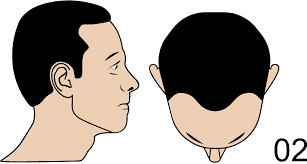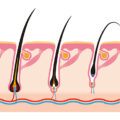Last updated on June 3, 2024
[starbox]
Our faces are generally shaped by two factors – our eyebrows and our hairline (or receding hairline). It’s not uncommon for men and women to feel uncomfortable about their hairline – regardless of what shape it may be. Many people compare their hairline to others and wonder why it is so different. Some people embrace their hairline while others chose a Hair Transplant or forehead reduction surgery to attain their desired shape and reduce hair loss or a receding hairline. However, monitoring your hairline for any important changes can help identify the early signs of Male Pattern Baldness.
What is a M-shaped Hairline?
As the name indicates, this particular hair loss pattern takes an “M” shape as the hair follicles on the forehead and the temporal region start receding. It can look slightly similar to a widow’s peak hairline, but they are not the same thing. The main difference is that a widow’s peak is curved up the sides and meets in a triangular midpoint, whereas an M-shaped hairline is much more triangular, even along the sides.
A widow’s peak or widow’s peak hairline is not normally a sign of future baldness, whereas an M shaped hairline could be the result of some hair loss.
Does an M-shaped hairline mean you are balding?
Normal hairlines come in many different shapes including low, middle, high, widow’s peak, bell, and many more. Although an M-shaped hairline doesn’t always mean that you are balding or suffering from male pattern hair loss or female pattern baldness, it is a strong sign that you are. However hairlines can, in turn, recede in different ways; it’s possible to get an M-shaped hairline after it recedes horizontally, which leaves more of your forehead exposed. Hair loss is often assessed on the Norwood scale for men and the Ludwig scale for women, and it’s a good guide to see where you sit on the hair loss scale. An M-shaped hairline will normally be considered Norwood stage 2 – 3, for example.
What causes an M-shaped hairline?
M-shaped hairlines are commonly associated with hair loss. If you’ve noticed that your natural hairline is gradually turning into more of an M-shape, here are some of the potential causes:
Hormones: The hormone Dihydrotestosterone (DHT), plays an important role in hairline development. If you are producing higher levels of it, hair loss can be a major side effect in men.
Stress: It’s well now the factor stress can have on the body – this certainly applies to the hair. The good news is however, hair loss due to stress (also known as telogen effluvium) is normally only temporary.
Age: As we grow older, or hit puberty, our hairlines can change greatly – sometimes starting to recede and start to look like more of an M-shape.
Genetics: Researchers have identified specific genes responsible for pattern baldness, which can lead to an M hairline. More than 200 independent genetic signals link to male pattern baldness.
How can I fix my M-shaped hairline?
The most effective and permanent hair growth treatment for a receding hairline is a hair transplant, however, some patients may be suitable for non-surgical hair loss treatment options to assist to regrow hair such as PRP or medication. The best starting point is to speak to a hair restoration professional about your hairline shape who will be able to diagnose and offer suitable hair loss treatment options.









